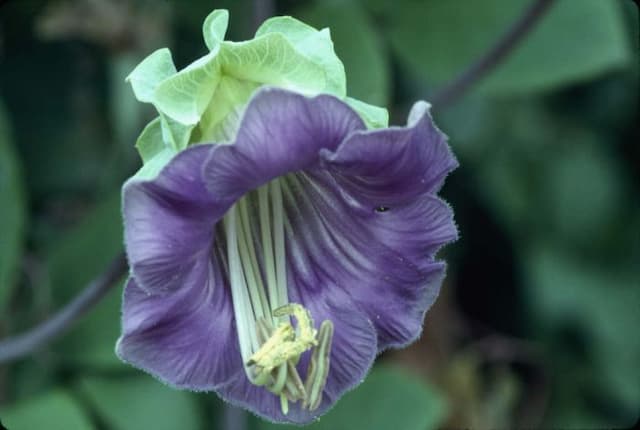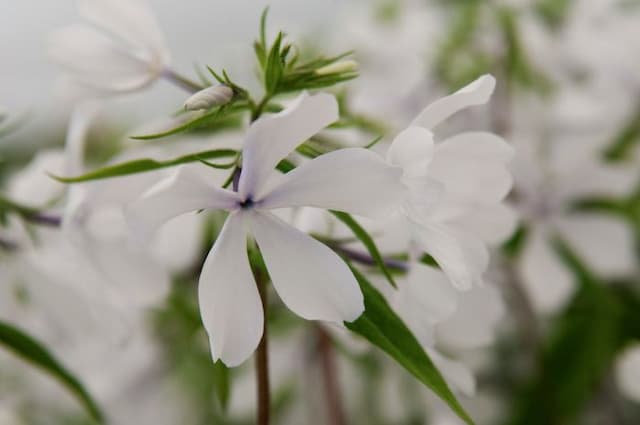Garden Phlox Phlox paniculata 'David'

ABOUT
The garden phlox variety known as 'David' is renowned for its showy clusters of brilliant white flowers that grace the top of the stems. These blossoms are richly fragrant and create a striking contrast against the deep green, lance-shaped foliage that serves as a lush backdrop. The flowers themselves are composed of several individual florets that come together in a dense, pyramidal form. Each floret has a small, tubular base that flares out into five flat, petal-like lobes. The plant has a bushy, upright growth habit with sturdy stems that are sometimes tinged with green to purplish hues, supporting the weight of the flower heads. The foliage is equally attractive; the leaves are pointed, with a slightly textured surface and smooth edges, which complement the blooms and maintain ornamental value even when the plant is not in flower. The overall appearance of Phlox paniculata 'David' is of a lush, vibrant plant that brings a bright and refreshing look to any garden setting with its crisp white flowers and rich greenery.
About this plant
 Names
NamesFamily
Polemoniaceae
Synonyms
Garden Phlox, Summer Phlox, Perennial Phlox, Tall Phlox
Common names
Phlox paniculata 'David'.
 Toxicity
ToxicityTo humans
Garden Phlox (Phlox paniculata 'David') is generally considered non-toxic to humans. It is not known to contain any harmful substances that would lead to poisoning if touched or ingested. However, it is always recommended to keep plants out of reach of small children who may chew on them, and to not consume any parts of ornamental plants as they are not food items and could cause an upset stomach or an allergic reaction in some individuals.
To pets
Garden Phlox is also generally considered non-toxic to pets. It does not typically pose a risk of poisoning to dogs, cats, or other domestic animals if they happen to ingest parts of the plant. However, consumption of non-food plants can sometimes result in mild gastrointestinal upset for pets, such as vomiting or diarrhea, so it is prudent to keep ornamental plants away from pets to prevent any potential issues.
 Characteristics
CharacteristicsLife cycle
Perennials
Foliage type
Deciduous
Color of leaves
Green
Flower color
White
Height
3-4 feet (0.9-1.2 meters)
Spread
2-3 feet (0.6-0.9 meters)
Plant type
Herb
Hardiness zones
4
Native area
North America
Benefits
 General Benefits
General Benefits- Attracts Pollinators: Phlox 'David' is known for drawing in bees, butterflies, and other beneficial insects, which can help pollinate your garden.
- Easy to Grow: This variety is relatively low-maintenance, making it a good choice for gardeners of all skill levels.
- Disease Resistant: Phlox 'David' has a good resistance to powdery mildew, a common problem with some other phlox varieties.
- Fragrant Flowers: The blooms emit a sweet fragrance that can add a pleasant aroma to your garden or living space.
- Long Blooming Period: Phlox 'David' has a lengthy flowering period, often from mid-summer through early fall, providing long-lasting color.
- Landscape Versatility: It can be used in a variety of garden settings, including borders, cottage gardens, and as cut flowers for arrangements.
- Drought Tolerant: Once established, it can tolerate periods of drought, making it suitable for gardens with less frequent watering.
- Deer Resistant: This plant is not a preferred food source for deer, reducing the likelihood of damage in areas where deer are a concern.
 Medical Properties
Medical PropertiesThis plant is not used for medical purposes.
 Air-purifying Qualities
Air-purifying QualitiesThis plant is not specifically known for air purifying qualities.
 Other Uses
Other Uses- Garden Phlox 'David' can be used as a natural dye source for fabrics. The flowers, when boiled, can impart subtle colors to textiles.
- Scent enhancement in potpourris. Dried Garden Phlox flowers can be added to potpourris to enrich the fragrance.
- Edible flowers. Although not commonly consumed, the petals of Garden Phlox 'David' can be used in salads to add a mild, spicy flavor and a touch of elegance.
- Theme gardens. Garden Phlox is ideal for 'moon gardens' where the goal is to have a garden that glows in the moonlight, complementing other white flowers and foliage.
- Photography. With its striking white blooms, Garden Phlox 'David' serves as an excellent subject or backdrop for garden photographers.
- Educational tool. This plant can be used to teach about pollination and the role of butterflies and moths, which are attracted to its flowers.
- Art inspiration. Artists can utilize the beauty of Garden Phlox 'David' as a muse for paintings, textiles, or other art forms.
- Wedding decor. Fresh or dried Phlox flowers can be used in floral arrangements, bouquets, or as table decorations for weddings and other events.
- Companion planting. Garden Phlox 'David' can be planted alongside vegetables to attract pollinators, which may increase crop yield.
- Seasonal celebrations. The blooms of Garden Phlox can be used for decoration during spring and summer festivals or celebrations, bringing natural, seasonal flair to events.
Interesting Facts
 Feng Shui
Feng ShuiThe Garden Phlox is not used in Feng Shui practice.
 Zodiac Sign Compitability
Zodiac Sign CompitabilityThe Garden Phlox is not used in astrology practice.
 Plant Symbolism
Plant Symbolism- Agreement - Phlox has been historically used to symbolize agreement or unity, which might be derived from its habit of growing in clusters, suggesting harmonious relationships.
- Harmony - 'David' offers a visual representation of harmony with its consistent and orderly flowering, which signifies peaceful coexistence.
- Proposal - In the language of flowers, phlox can be used to propose love or companionship, possibly because of its appealing and vibrant appearance.
- Sweet Dreams - The gentle and soothing presence of phlox, particularly the 'David' variety with its white blooms, is thought to symbolize sweet dreams and tranquil sleep.
- Unity - The tight clusters of flowers on the 'David' phlox symbolize the idea of unity or coming together, making it a plant often selected for planting in community gardens or given in gatherings.
 Water
WaterGarden Phlox should be watered deeply, ensuring the soil is moist but not waterlogged. During the growing season, water the plant thoroughly once a week, providing about one gallon of water per plant. In periods of hot or dry weather, watering frequency may need to increase to twice a week. Avoid overhead watering to help prevent powdery mildew and other fungal diseases. It is critical to maintain consistent moisture levels, particularly when the plant is setting buds and blooming.
 Light
LightGarden Phlox thrives best in full sun, meaning it requires at least six hours of direct sunlight each day. An ideal spot would be in an area that receives morning sunlight and is partially shaded in the late afternoon, for regions with hot summers. However, it can also tolerate light shade, especially in hotter climates.
 Temperature
TemperatureGarden Phlox prefers moderate temperatures and can typically tolerate a range from 60 to 70 degrees Fahrenheit during the day. It can survive minimum temperatures as low as -30 degrees Fahrenheit and maximum summer temperatures up to 90 degrees Fahrenheit. The ideal temperature for optimal growth and flowering is between 65 and 75 degrees Fahrenheit.
 Pruning
PruningGarden Phlox benefits from pruning to encourage a bushier growth habit and to promote better air circulation. Prune in early spring by cutting back last year's stems to about one to two inches above the ground. Deadhead spent flowers regularly to encourage further blooming. The best time for major pruning is just before new growth begins in spring.
 Cleaning
CleaningAs needed
 Soil
SoilGarden Phlox thrives in a soil mix with rich loam that is well-drained, with added compost or manure to enhance fertility. Aim for a slightly acidic to neutral pH, around 6.5 to 7.0.
 Repotting
RepottingGarden Phlox typically doesn't require frequent repotting and can be repotted every 2 to 3 years or if it outgrows its current container.
 Humidity & Misting
Humidity & MistingGarden Phlox does well in average humidity conditions; it does not require high humidity and thrives outdoors in its natural environment.
 Suitable locations
Suitable locationsIndoor
Place in a sunny spot with moist, well-draining soil.
Outdoor
Choose a sunny site with rich, moist, well-drained soil.
Hardiness zone
4-8 USDA
 Life cycle
Life cycleGarden Phlox 'David' starts its cycle as seeds, which upon germination in early spring, develop into small seedlings. As temperatures warm, these seedlings grow into sturdy stems with lance-shaped leaves. Throughout the summer, the plant reaches maturity and produces large clusters of fragrant white flowers that attract pollinators. After flowering, the plant sets seed, dispersing them to produce new plants in subsequent seasons. As fall arrives, the plant begins to die back and enters a period of dormancy through the winter months. In the following spring, Garden Phlox 'David' can re-emerge from its root system or from the new seeds that were spread, continuing its life cycle.
 Propogation
PropogationPropogation time
Spring-Early Summer
Garden Phlox, known as Phlox paniculata 'David', is a popular perennial that can be propagated in several ways, but division is the most commonly used method. The ideal time to propagate Garden Phlox by division is in early spring or late summer to early fall, when the plant is not in active bloom. To propagate through division, you start by digging up an established clump and gently separating it into smaller sections, making sure each section has several shoots and a healthy root system. These sections can then be replanted at the same soil depth as the original plant and spaced about 18 to 24 inches apart (approximately 45 to 60 centimeters) to allow for growth. Water the new divisions thoroughly after planting to help establish them. With proper care, these divisions will grow into strong, flowering plants in the following season.









